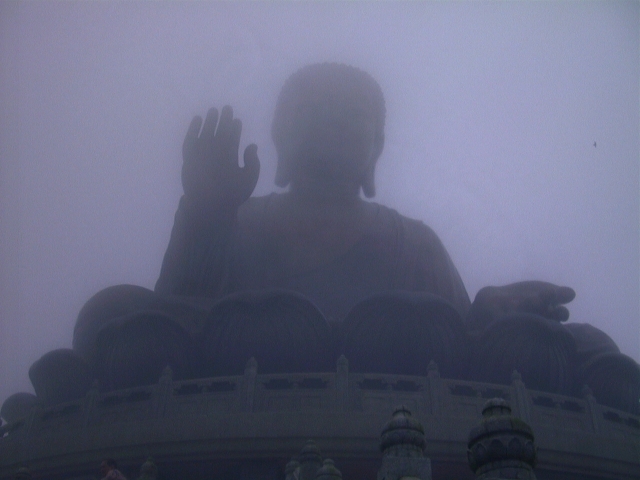Mo-shan Liao-Jan, a disciple of Kao-an Ta-yu, is the first woman Dharma heir in the official Ch'an Transmission Line and the first recorded woman who was the teacher of a man.
Mo-shan, which means Summit Mountain, was well known in her time (around 800 A.D.) and referred to by many later writers. She is one of the role models of wisdom cited by Dogen Zenji in his chapter Raihai-tokuzu. Miriam Levering, who has translated records on Mo-shan, writes, she is "the first nun to be portrayed in Ch'an texts as doing what male teachers do - being an abbess, welcoming and challenging students in that role." Mo-shan has a chapter in the Chinese book of Enlightenment stories called the Cheng-te ch'uan-teng lu, the Record of the Transmission of the Lamp, from 1004 A.D.
When the Chinese monk Kuan-ch'i Chih-hsien was traveling in search of
a teacher, he came to Mo-shan's temple:
"What place did you leave today?" she asked him."I left the entrance to the road," he answered.
"Why didn't you cover it?" Mo-shan asked. He had no answer, and bowed.
Then he asked, "What is Mo-shan like?"
"It does not expose its peak," she said.
"What is the owner of Summit Mountain like?"
"It does not have male or female appearance," Mo-Shan said.
Chih-hsien shouted "Ho!" and added, "Why doesn't it transform itself?"
"It is not a god and it is not a ghost," said Mo-shan. "What should it transform itself into?"
Chih-hsien submitted to her teaching for three years.
The most significant point that Mo-shan made in the above
encounter was that she had no interest in supernatural powers,
because it had nothing to do with Enlightenment. Mo-shan understood that it is through
Enlightenment that supernatural powers are manifested, rather than
that supernatural powers enhance Enlightenment.
Buddhism teaches that after a practitioner achieves a certain degree of realization, spiritual power, known in Sanskrit as Siddhis, develops. An Arhat is said to possess a variety of supernatural powers.
It must be understood, as did Mo-shan, that the Buddha was cognizant of the fact that there are those who devote themselves to yogic and meditative exercises only to acquire supernatural powers. The Buddha impressed on his devotees that acquisition of supernatural powers did not confer any special spiritual advantage. It was for this reason that the Buddha forbade his disciples to work miracles for display. Craving for supernatural powers and taking delight therein after acquirement does not help to free one from The Three Poisons (desire, hatred and ignorance). It is advised that anyone striving along the path of holiness toward final liberation guard themselves to not get caught up in it all and forget the true purpose.
The following should be of interest:
1. IDDHIVIDHA - THE POWER OF TRANSFORMATION: (see)
The Buddha said "If a monk should frame a wish as follows: "Let me exercise the various magical powers, let me being one become multiform., let me being multiform become one, let me become visible, become invisible, go without hindrance through walls, ramparts or mountains as if through air, let me rise and sink in the ground as if in the water, let me walk on the water as if on unyielding ground, let me travel through the air like a winged bird, let me touch and feel with my hand the moon and the sun mighty and powerful though they are, and let me go without my body even up to the Brahma world," then must he be perfect in the precepts (Sila), bring his thoughts to a state of quiescence (Samadhi), practice diligently the trances (Jhana), attain to insight (Prajna) and be frequenter to lonely places.
AKANKHEYYA SUTTA, Vol. XI of The Sacred Books of the East [14]
For the record, it should be noted that super-normal perceptual states, sometimes refered to as supernatural powers, are not attainable exclusively by Buddhists and are well known in Hindu and the occult. It is possible for anyone who has deep religious and spiritual cultivation to develop some kind of super-normal powers.
Mo-shan was also known as: Moshan Liaoran, Laoran, Massan Ryonen, Myoshin, Miao-Hsin. Dharma-heir of Gaoan Dayu, one of Linji’s teachers, she was a teacher of Linji’s disciple, Guanzhi Zhixian (Kuan-ch'i Chih-hsien) as well.
SHANGRI-LA, SHAMBHALA, GYANGANJ, BUDDHISM AND ZEN
HUI SHEN
Fundamentally, our experience as experienced is not different from the Zen master's. Where
we differ is that we place a fog, a particular kind of conceptual overlay onto that experience
and then make an emotional investment in that overlay, taking it to be "real" in and of itself.

(PLEASE CLICK)
|

HERE FOR
ENLIGHTENMENT

ON THE RAZOR'S
EDGE
THE WANDERLING
(please click)
SEE:
IN THE WAY OF ENLIGHTENMENT: The Ten Fetters of Buddhism.
Bodhidharma, Hui'ko, Hui Shen, Hui Neng, Shih-t'ou Hsi-ch'ien, Zhaozhou, Moshan Liaoran, Mugai Nyodai,
Nagarjuna, Ganapati Muni, Kuan Yin, Miao Shan, Tung-Shan, Lin Chi, Te Shan, Dogen
